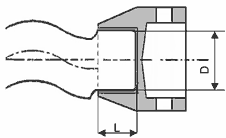8.2.3.2 Example:
Torque Transmission
If the medium being pumped is particularly
aggressive, the metallic rotors of eccentric screw pumps are
subject to high levels of mechanical wear. SiC rotors are
significantly harder than metal rotors, and offer a service
life up to 20 times longer.
Force is introduced to the rotor through a pin joint. Because
the ceramic reacts sensitively to impact and tensile stress
it is not helpful to make the rotor entirely out of ceramic.
An appropriate jointing method is therefore required in order
to use ceramic rotors and to exploit the benefits of ceramic
material.
Gluing may be an appropriate jointing technique for such a
case. When designing the joint for an eccentric screw it is
necessary to bear the following points in mind:
- the material of the (metal) head,
- the size and type of the forces that occur,
- the maximum temperature in application and
- the surrounding medium.

Figure 205: A silicon carbide eccentric screw
The necessary surface preparation (e.g. degreasing
and sand blasting), and treatment of the surfaces where relevant,
depend on the silicon carbide used for the eccentric screw
and the stainless-steel or hardened tool steel of the head.
Some materials have passive surfaces that must be treated
with bonding agents in order to ensure adequate adhesion between
the glue and the jointed part.

Figure 206: Gluing location of the eccentric
screw
The type and magnitude of the stresses that
occur in operation will determine the design and dimensioning
of the glued areas and the selection of the glue. Eccentric
screws are primarily subjected to torsional stress, which
means that gluing to the face is not effective. The force
is therefore introduced around the circumference of a centralised
head.
The sizes of the glued areas depend on the maximum forces.
The moment (Nm) that can theoretically be transmitted can
be calculated from the following formula:

where  t
is the adhesion strength of the glue, D is the diameter of
the joint, and L the length of the glued region. t
is the adhesion strength of the glue, D is the diameter of
the joint, and L the length of the glued region.
The stress on the joint, however, should
not exceed 10 % - 30 % of the theoretical strength, depending
on the glue in use.
The operating temperature is very important for the choice
of glue. The maximum application temperatures of glues based
on organic materials reach up to 400°C. If the temperature
is too high the layer of glue will soften or decompose, and
the joint will rapidly fail.
The effect of the surrounding medium is relevant to the long-term
stability of the glued joint. The strength of some glues drops
sharply if, for instance, moisture diffuses into the material.
|

